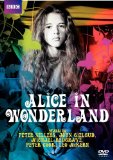| Reviews & Columns |
|
Reviews DVD TV on DVD Blu-ray 4K UHD International DVDs In Theaters Reviews by Studio Video Games Features Collector Series DVDs Easter Egg Database Interviews DVD Talk Radio Feature Articles Columns Anime Talk DVD Savant Horror DVDs The M.O.D. Squad Art House HD Talk Silent DVD
|
DVD Talk Forum |
|
|
| Resources |
|
DVD Price Search Customer Service #'s RCE Info Links |
|
Columns
|
|
|
Alice in Wonderland ('66 BBC)
BBC Worldwide // Unrated // March 2, 2010
List Price: $14.98 [Buy now and save at Amazon]
The TV Production (Film):
Picture the stereotype of a poet from the '60s, sitting on a stool in a smoky, dimly lit room wearing a black beret and holding a distant, idiosyncratic gaze. Now, add a sitar and a thumping drum as musical backdrop, and imagine the poet rattling off the lines of Lewis Carroll's book "Alice's Adventures in Wonderland". Jonathan Miller's take on the fable, a 1966 production shot for the BBC, mirrors that experience. At first, his renaissance-man panache reflects a quirky, gothic charm, enhanced by inventive visuals and a unique narrative voice from Alice; however, the production gradually exhausts its appeal later on and begins running solely off its own peculiarity, much like what it'd be like to hear that passionate oddball poet rattle off Carroll's prose like indulgent free-form balladry.
That, however, occurs quite a while after Miller makes an impression on his audience with a visually inventive spin on the story's beginnings. Most know it without having seen or read Carrol's narrative; Alice, played here with fawn-like, honest fervor by young Anne-Marie Mallik, zips down the rabbit hole and into the waiting room to go into Wonderland after following a hasty, time-conscious rabbit. After drinking a shrinking potion, eating growth cake, and finding the balance between the two, she finally sets out into the surreal world that stretches beyond a miniature door in the room she's been peeking through. It's a dream, somewhat, one that's obviously both a mental and physical maze through talking animals, bloodthirsty royals, and a hatter that's a bit bonkers.
Oddly, you won't see much of that in a literal form within Jonathan Miller's "Alice in Wonderland", as he steers away from plainly recreating the fanciful creatures -- best fitted for Disney's '50s animated work. His reasoning is sound; essentially, he didn't feel like he should gussy up a host of fine actors in concealing make-up and frumpy costumes, so he allows for their talents to mold into the relevant characters. Instead, they're all dressed to the nines in bold Victorian garb, emphasizing the hoity-toity tightness surrounding the wild-haired Alice. Miller's tactics in characterization are inspired, agreeable and partly successful, but they suffer from squelching our intrigue into the razzmatazz of Wonderland in the process. In trying to be overtly unique, he squanders away a bit of direct captivation.
Maybe it's because the visual creativity bridles itself at that point, deviating from the magnificently lyrical imagery present at the beginning of the production. As Alice moves closer to Wonderland, down the rabbit hole in a figurative sense, she weaves through a bridge's underlying tunnel and through the halls of an abandoned building through gorgeous black-and-white photography. Windows pour in sunlight through the hallways, adorned with tentacle-like lace curtains that reach out to Alice like an urchin to a small deep-sea fish. Once she arrives to the "waiting room" outside Wonderland, Miler's inventiveness with production design crafts what could possibly be the simplest yet most effective construction of Alice's shrinking and growing shot on camera. It's a mixture of period-worn editing and clever set design that beautifully creates that fanciful moment.
At its start, "Alice in Wonderland" finds a rhythm -- literally -- that creates something genuinely singular out of Lewis Carroll's story. These visual concepts are accompanied by original music from Ravi Shankar, both sitar and drum-heavy tunes that propel Alice along her journey with an exotic flare that, as out of place as it might seem, works wonders in creating a deep-seated tone. The blend between Mallik's languid glances and Miller's aesthetic is entrancing; an erratic poise forms from the obscurity that gives us order from chaos, creating a vision that's oddly focused. It's neither a bright, bouncy dream nor a dark nightmare, but something in the nebulous amid the two.
Yet there's a whole other half to "Alice in Wonderland", a talky, odd follow-up to this pointed launch, and our tolerance for Miller's bizarre construction weakens as the dialogue flourishes between the not-so-fanciful creatures. A vein of enthusiasm still exists in watching the actors mold their characters without the use of a visual representation, along with watching Anne-Marie Mallik's faint dramatic adjustments and vocal tonal shifts. It transforms more into an indulgent glance at the actors' hit-and-miss abilities in shaping the characters, instead of a cohesive follow-up to the roots established with the stark introduction. Still, Wilfred Brambell's a hoot as the White Rabbit, Sir Michael Redgrave is charismatically alluring as the Caterpillar, while Peter Sellers sneaks in at the last minutes as a peculiar King of Hearts. Others aren't as clear-cut winning, such as Bedazzled's Peter Cook as an awkward Mad Hatter.
After a breezy start, "Alice in Wonderland" feels every bit of its 77-minute length once the second half of the production arrives. Mallik's narration still grabs our attention, but it's becoming a bit droll and monotonous against the less-than-whimsical backdrops created for Alice's spiral into Wonderland. That doesn't mean that Jonathan Miller's loses his vision, as his eye for recreating the tea party and Alice's time in court with the Heart royals remains compelling, but cleverness soon begins to wear thin as the magic leaves and the chatter continues. He's noticeably more in element with the story's capricious magic, and the moments at the beginning -- throttled by Ravi Shankar's music and Miller's eye for visual wonder -- are indeed worth the middling yet interesting stride to the conclusion of Alice's story.
The DVD:
Video and Audio:
Though the cover artwork and menu design are vibrant and multihued, don't expect any color in the BBC's stunning replication of this 1.33:1 black and white photography. Quite honestly, I couldn't imagine what the picture would look like outside of its grayscale imagery, because the somewhat grim, downcast tones to its visuals are so splendid to witness that the idea of color within its composition doesn't seem appealing. As far as the transfer itself, the BBC have really done an excellent job in preserving a true motion, tightness to detail, and immaculate level of contrast to the image, only showcasing a few points of significant print damage in a handful of scenes. It's an impressive visual treatment that certainly doesn't look nearly 40 + years old at the time of this DVD's release.
Naturally, a '60s television broadcast wouldn't carry a lustrous sound offering, but the Mono track does its due diligence in keeping the dialogue clean and the distortion to a minimum. The dialogue clearly carries its age with a bit of period-laden coarseness, especially with Mallik's narration voiceover, but it never buzzes or clips out to any disappointing degrees. The real star of this track is Ravi Shankar's rhythmic musical accompaniment, which works within a splendid breadth between well-pitched high percussion sounds and throaty low-end taps against the drums. Woodwinds dance around a midrange sound gradient that's very pleasing to the ears, while the sitar tests buoyancy with excellent, almost goosebump-inducing precision. Very pleasing. The only subtitles available are in English SDH text.
Special Features:
Director's Commentary with Jonathan Miller:
Miller is well in-tune with the source material, clear by his initial comments in this commentary. He voices his disconcert with the "absurd" Disney adaptation, giving us information on how he felt that most of the filmed versions strayed of the disturbing context of Carroll's book. Most of the commentary discusses these out-of-the-box generalizations about his work in adapting the narrative, but the context that he discusses -- his own interpretation of the material -- provides a very engaging listen. He discusses Carroll's investment in symbolic logic, the "surrealist vividness" of dreams, and how he comprised lines of dialogue the morning of shooting -- on a 9mm lens -- and "just playing" the scenes.
Ravi Shankar Plays for Alice (9:21, 4x3):
This piece showcases Shankar's process in composing the music for Alice in Wonderland. We get a glimpse of the process behind-the-scenes, watching at the composer as he eyes the film -- which he's seen several times before his recording -- and concocts his signature rhythm for its dream-like flow. The quality of the recording is surprisingly good, as is the visual treatment for the content itself while we hear mumblings between Shankar and his other musicians/crew.
Two other full-length productions have also been included on the disc. The first, Cecil Hepworth's 1903 silent version of "Alice in Wonderland" (8:32, 4x3), is the first-ever caught on tape. The narrative is indistinct within the production itself, but those familiar with the storyline will find the visual tricks -- including the grace in making Alice grow early on -- are impressive. Sadly, we're not able to watch just the film itself without commentary from Simon Brown (unless, obviously, the mute button is hit), though his insight is very welcome when it's on. Along with that, Dennis Potter's lengthy 1965 biopic on Alice Liddel for The Wednesday Play (1:10:59, 4x3), the inspiration for the Alice in our story, is also available, along with a pretty great in-motion Stills Gallery (2:11).
Final Thoughts:
Jonathan Miller's "Alice in Wonderland" is certainly unlike most takes on the material that you've seen before. A uniquely compelling tone rises from the construction of its visuals, Ravi Shankar's moody scoring and the reliance on the actors' talents and its Victorian costume design instead of animal costumes for its characters. Though the front half of Miller's production gets all of this right, easily one of the best descents into Wonderland I've seen, the pacing and manner drags once the dialogue grows heavier in the second act. That shouldn't, by any means, stop one from seeing this production, as it's quite the oddly beautiful adaptation of Lewis Carroll's work. Add on top of that the adequately-handled audiovisual treatment and the strong slate of extras -- including a commentary with director Miller, a silent version of Alice from 1903, and a behind-the-scenes glimpse at Shankar's musical construction -- and you've got a Highly Recommended disc (especially at that price) that's right up there with the better representations of the material.
Thomas Spurlin, Staff Reviewer -- DVDTalk Reviews | Personal Blog/Site
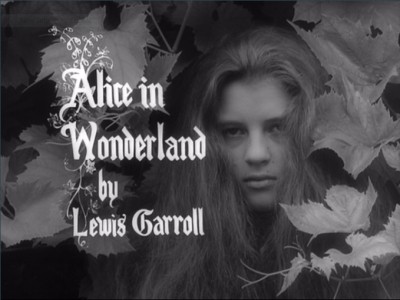 |
That, however, occurs quite a while after Miller makes an impression on his audience with a visually inventive spin on the story's beginnings. Most know it without having seen or read Carrol's narrative; Alice, played here with fawn-like, honest fervor by young Anne-Marie Mallik, zips down the rabbit hole and into the waiting room to go into Wonderland after following a hasty, time-conscious rabbit. After drinking a shrinking potion, eating growth cake, and finding the balance between the two, she finally sets out into the surreal world that stretches beyond a miniature door in the room she's been peeking through. It's a dream, somewhat, one that's obviously both a mental and physical maze through talking animals, bloodthirsty royals, and a hatter that's a bit bonkers.
Oddly, you won't see much of that in a literal form within Jonathan Miller's "Alice in Wonderland", as he steers away from plainly recreating the fanciful creatures -- best fitted for Disney's '50s animated work. His reasoning is sound; essentially, he didn't feel like he should gussy up a host of fine actors in concealing make-up and frumpy costumes, so he allows for their talents to mold into the relevant characters. Instead, they're all dressed to the nines in bold Victorian garb, emphasizing the hoity-toity tightness surrounding the wild-haired Alice. Miller's tactics in characterization are inspired, agreeable and partly successful, but they suffer from squelching our intrigue into the razzmatazz of Wonderland in the process. In trying to be overtly unique, he squanders away a bit of direct captivation.
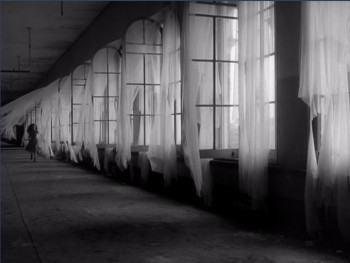 | 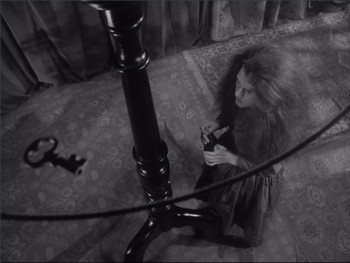 |
Maybe it's because the visual creativity bridles itself at that point, deviating from the magnificently lyrical imagery present at the beginning of the production. As Alice moves closer to Wonderland, down the rabbit hole in a figurative sense, she weaves through a bridge's underlying tunnel and through the halls of an abandoned building through gorgeous black-and-white photography. Windows pour in sunlight through the hallways, adorned with tentacle-like lace curtains that reach out to Alice like an urchin to a small deep-sea fish. Once she arrives to the "waiting room" outside Wonderland, Miler's inventiveness with production design crafts what could possibly be the simplest yet most effective construction of Alice's shrinking and growing shot on camera. It's a mixture of period-worn editing and clever set design that beautifully creates that fanciful moment.
At its start, "Alice in Wonderland" finds a rhythm -- literally -- that creates something genuinely singular out of Lewis Carroll's story. These visual concepts are accompanied by original music from Ravi Shankar, both sitar and drum-heavy tunes that propel Alice along her journey with an exotic flare that, as out of place as it might seem, works wonders in creating a deep-seated tone. The blend between Mallik's languid glances and Miller's aesthetic is entrancing; an erratic poise forms from the obscurity that gives us order from chaos, creating a vision that's oddly focused. It's neither a bright, bouncy dream nor a dark nightmare, but something in the nebulous amid the two.
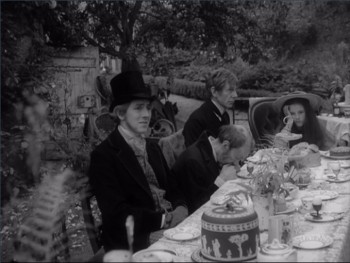 | 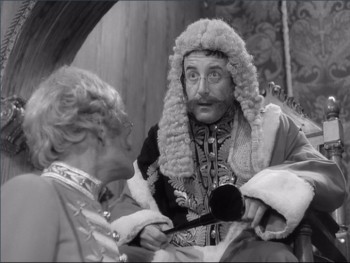 |
Yet there's a whole other half to "Alice in Wonderland", a talky, odd follow-up to this pointed launch, and our tolerance for Miller's bizarre construction weakens as the dialogue flourishes between the not-so-fanciful creatures. A vein of enthusiasm still exists in watching the actors mold their characters without the use of a visual representation, along with watching Anne-Marie Mallik's faint dramatic adjustments and vocal tonal shifts. It transforms more into an indulgent glance at the actors' hit-and-miss abilities in shaping the characters, instead of a cohesive follow-up to the roots established with the stark introduction. Still, Wilfred Brambell's a hoot as the White Rabbit, Sir Michael Redgrave is charismatically alluring as the Caterpillar, while Peter Sellers sneaks in at the last minutes as a peculiar King of Hearts. Others aren't as clear-cut winning, such as Bedazzled's Peter Cook as an awkward Mad Hatter.
After a breezy start, "Alice in Wonderland" feels every bit of its 77-minute length once the second half of the production arrives. Mallik's narration still grabs our attention, but it's becoming a bit droll and monotonous against the less-than-whimsical backdrops created for Alice's spiral into Wonderland. That doesn't mean that Jonathan Miller's loses his vision, as his eye for recreating the tea party and Alice's time in court with the Heart royals remains compelling, but cleverness soon begins to wear thin as the magic leaves and the chatter continues. He's noticeably more in element with the story's capricious magic, and the moments at the beginning -- throttled by Ravi Shankar's music and Miller's eye for visual wonder -- are indeed worth the middling yet interesting stride to the conclusion of Alice's story.
The DVD:
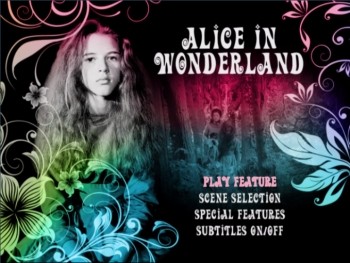 | 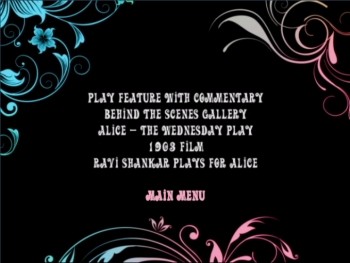 |
Video and Audio:
Though the cover artwork and menu design are vibrant and multihued, don't expect any color in the BBC's stunning replication of this 1.33:1 black and white photography. Quite honestly, I couldn't imagine what the picture would look like outside of its grayscale imagery, because the somewhat grim, downcast tones to its visuals are so splendid to witness that the idea of color within its composition doesn't seem appealing. As far as the transfer itself, the BBC have really done an excellent job in preserving a true motion, tightness to detail, and immaculate level of contrast to the image, only showcasing a few points of significant print damage in a handful of scenes. It's an impressive visual treatment that certainly doesn't look nearly 40 + years old at the time of this DVD's release.
Naturally, a '60s television broadcast wouldn't carry a lustrous sound offering, but the Mono track does its due diligence in keeping the dialogue clean and the distortion to a minimum. The dialogue clearly carries its age with a bit of period-laden coarseness, especially with Mallik's narration voiceover, but it never buzzes or clips out to any disappointing degrees. The real star of this track is Ravi Shankar's rhythmic musical accompaniment, which works within a splendid breadth between well-pitched high percussion sounds and throaty low-end taps against the drums. Woodwinds dance around a midrange sound gradient that's very pleasing to the ears, while the sitar tests buoyancy with excellent, almost goosebump-inducing precision. Very pleasing. The only subtitles available are in English SDH text.
Special Features:
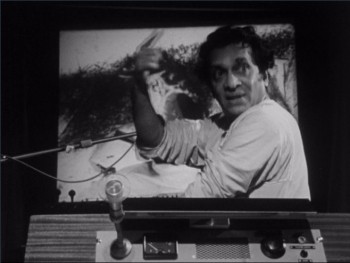 | 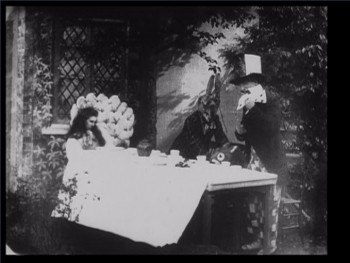 |
Director's Commentary with Jonathan Miller:
Miller is well in-tune with the source material, clear by his initial comments in this commentary. He voices his disconcert with the "absurd" Disney adaptation, giving us information on how he felt that most of the filmed versions strayed of the disturbing context of Carroll's book. Most of the commentary discusses these out-of-the-box generalizations about his work in adapting the narrative, but the context that he discusses -- his own interpretation of the material -- provides a very engaging listen. He discusses Carroll's investment in symbolic logic, the "surrealist vividness" of dreams, and how he comprised lines of dialogue the morning of shooting -- on a 9mm lens -- and "just playing" the scenes.
Ravi Shankar Plays for Alice (9:21, 4x3):
This piece showcases Shankar's process in composing the music for Alice in Wonderland. We get a glimpse of the process behind-the-scenes, watching at the composer as he eyes the film -- which he's seen several times before his recording -- and concocts his signature rhythm for its dream-like flow. The quality of the recording is surprisingly good, as is the visual treatment for the content itself while we hear mumblings between Shankar and his other musicians/crew.
Two other full-length productions have also been included on the disc. The first, Cecil Hepworth's 1903 silent version of "Alice in Wonderland" (8:32, 4x3), is the first-ever caught on tape. The narrative is indistinct within the production itself, but those familiar with the storyline will find the visual tricks -- including the grace in making Alice grow early on -- are impressive. Sadly, we're not able to watch just the film itself without commentary from Simon Brown (unless, obviously, the mute button is hit), though his insight is very welcome when it's on. Along with that, Dennis Potter's lengthy 1965 biopic on Alice Liddel for The Wednesday Play (1:10:59, 4x3), the inspiration for the Alice in our story, is also available, along with a pretty great in-motion Stills Gallery (2:11).
Final Thoughts:
Jonathan Miller's "Alice in Wonderland" is certainly unlike most takes on the material that you've seen before. A uniquely compelling tone rises from the construction of its visuals, Ravi Shankar's moody scoring and the reliance on the actors' talents and its Victorian costume design instead of animal costumes for its characters. Though the front half of Miller's production gets all of this right, easily one of the best descents into Wonderland I've seen, the pacing and manner drags once the dialogue grows heavier in the second act. That shouldn't, by any means, stop one from seeing this production, as it's quite the oddly beautiful adaptation of Lewis Carroll's work. Add on top of that the adequately-handled audiovisual treatment and the strong slate of extras -- including a commentary with director Miller, a silent version of Alice from 1903, and a behind-the-scenes glimpse at Shankar's musical construction -- and you've got a Highly Recommended disc (especially at that price) that's right up there with the better representations of the material.
|
| Popular Reviews |
| Sponsored Links |
|
|
| Sponsored Links |
|
|
| Release List | Reviews | Shop | Newsletter | Forum | DVD Giveaways | Blu-Ray | Advertise |
|
Copyright 2024 DVDTalk.com All Rights Reserved. Legal Info, Privacy Policy, Terms of Use,
Manage Preferences,
Your Privacy Choices | |||||||









